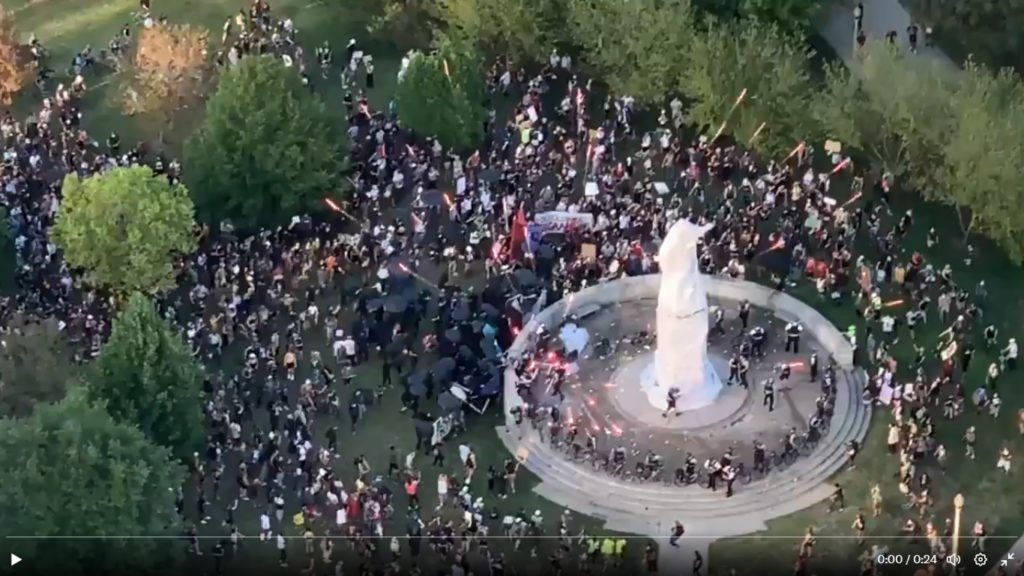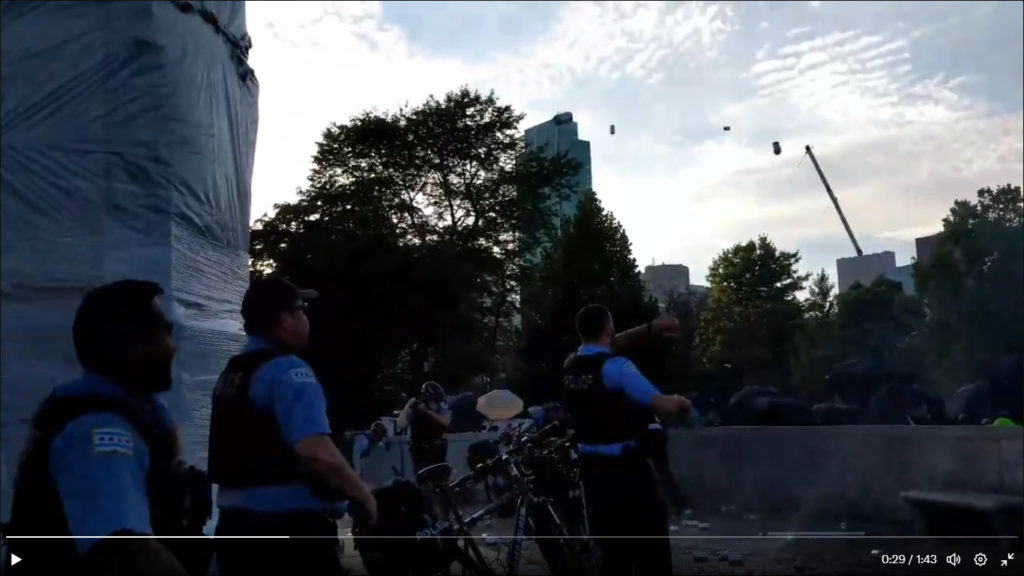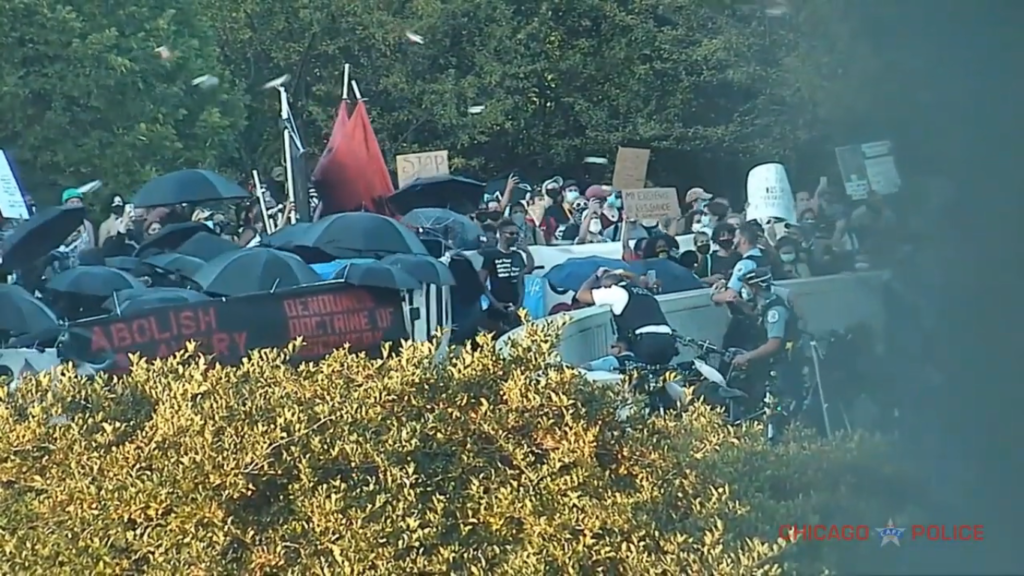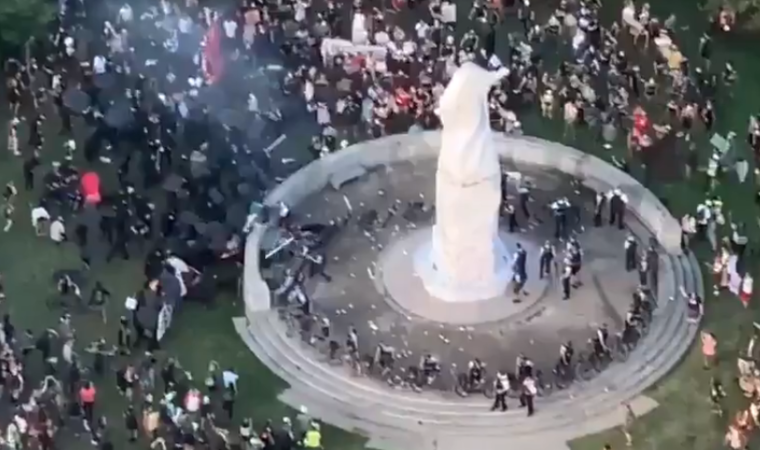Three years ago today, something significant happened — historically significant, it seems to me. Yet perhaps the most remarkable thing about it is how little it’s been written about. Will history recognize the Battle of Grant Park?
First of all: What exactly happened?
On a Friday evening, after weeks of unrest triggered by George Floyd’s murder, a large, peaceful protest suddenly transformed, in part, into an assault on police at the statue of Christopher Columbus in Grant Park, Chicago. Aerial and other video footage shows that at the end of a march, a group of protesters distribute frozen water bottles and cans, then begin hurling them at police guarding the statue, along with fireworks and PVC pipes, which had previously framed large protest banners at the front of the procession.
As you can see below, in a frame of an aerial video, a sizable group of protesters have raised black umbrellas above their heads, presumably to conceal their identities and/or activities, and are throwing bottles, cans and PVC pipes at the police. Reportedly, the ends of the pipes had been sharpened to a point. You can see the evidence of fireworks exploding inside the police perimeter. That short clip, and this one from the ground, convey what happened better than any still photograph could — in less than two minutes, total. This video gives another excellent view of the action.

The police were not prepared for this onslaught, and eventually had to retreat from their position. In all, 49 officers suffered injuries, including at least one eye injury from exploding fireworks and multiple concussions. Eighteen required hospitalization.
Ultimately, the activists secured ropes around the arm of the statue, but did not succeed in toppling it. They did manage to eject the police guarding it, and gain the opportunity — which is remarkable in itself.
This was clearly a well-coordinated, planned attack, not a spontaneous, riotous escalation of a protest inflamed beyond the bounds of control. It takes time for water to freeze inside bottles and cans. It takes time to sharpen the ends of PVC pipes. It takes time, planning, and coordination to get a group of people to pull off an action like this.

It was tactically sophisticated, guerrilla-style, low-intensity warfare in the heart of an American city. Seems noteworthy, to me.
Yet there seems to have been very little notice of it in the mainstream media. Google it, and you’ll find not much more than some local coverage, a few notices from conservative quarters, and the odd anarchist website applauding its effectiveness. Why so little?
I think it has something to do with the polarization of American politics, which is both reflected in and encouraged by our media culture. Many mainstream outlets take the side of the protesters, who purport, at least, to fight for racial justice. Focusing on violent actions from that side runs counter to the narrative they want to promote.
Narrative, I’m afraid, has become a powerful organizing principle for a lot of media organizations. Relying on narrative makes life easier for people who have to report on the news 24/7. That leaves little room for independent, critical analysis with the potential to complicate things.
But knowing about what happened at the Battle of Grant Park is important for understanding American politics, I believe. It demonstrates that left-wing activists are capable of carrying out well-planned, coordinated, violent assaults on public institutions. In fact, they typically display more operational sophistication than is seen on the right. The tactics employed here are not at all unprecedented for antifa and their allies. But they are rarely so easy to see.

The incident also shows us the anti-democratic character of this type of activism. There is a democratic process, after all, for removing a statue — and it was exercised a week later, when Mayor Lori Lightfoot ordered the statue taken down. These activists tried instead to realize their political goals by force.
It’s a good thing their attempts to bring down the statue failed, since it could easily have caused injuries otherwise. Ask Chris Green, who was struck in the head by a toppling Confederate statue in Portsmouth, Virginia, suffering a traumatic, life-changing brain injury.
I’ll note that the police later returned in riot gear, and violently cleared the area. It sounds like they may have used excessive force at times. That’s beside the point, here. They should be held accountable for their actions, of course.
The point here is to notice this violent, unlawful incident and consider what it tells us about our political landscape, and what its seemingly going so underreported tells us.
Democracy is a never-ending challenge: It’s not an easy thing. We need to be able to talk about it, to balance the interests of all members of society, and to protect their rights. It is not the rule of the mob. It depends on the rule of law, among other things.
If the Battle of Grant Park is memory-holed, we may fail to notice its significance to our politics, and then I think we’ll be missing something important about the challenges of democracy.

Thank you Dan for at the very least, contribution to a reasonable commentary, which in the very least helps us to realize that there really is at least some reasonableness in a world where much of what we see and hear, which I assume (hope) is not representative of what most think and feel. That is likely a secondary impact but frankly, worthy of note.